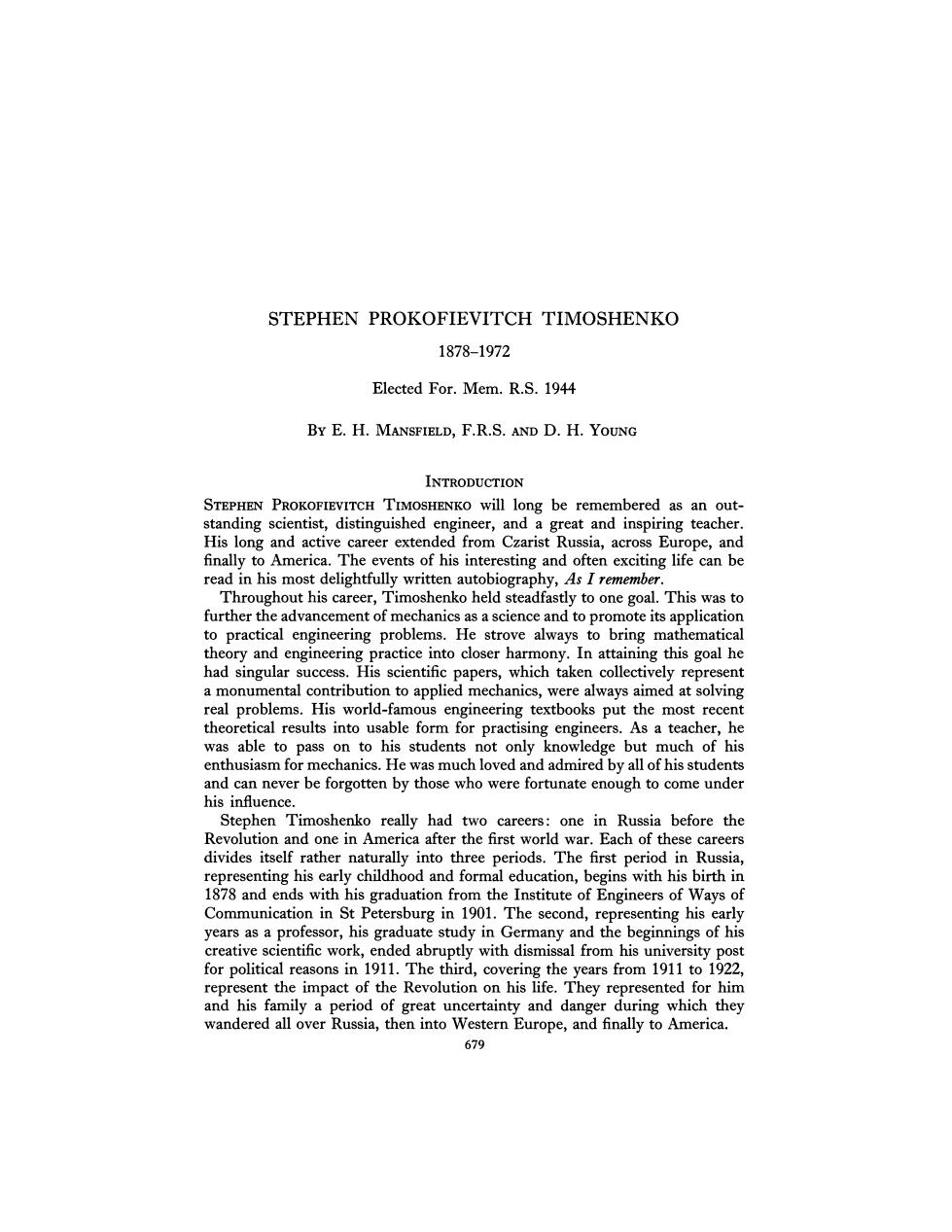
STEPHEN PROKOFIEVITCH TIMOSHENKO 1878-1972 Elected For.Mem.R.S.1944 BY E.H.MANSFIELD,F.R.S.AND D.H.YOUNG INTRODUCTION STEPHEN PROKOFIEVITCH TIMOSHENKO will long be remembered as an out- standing scientist,distinguished engineer,and a great and inspiring teacher. His long and active career extended from Czarist Russia,across Europe,and finally to America.The events of his interesting and often exciting life can be read in his most delightfully written autobiography,As I remember. Throughout his career,Timoshenko held steadfastly to one goal.This was to further the advancement of mechanics as a science and to promote its application to practical engineering problems.He strove always to bring mathematical theory and engineering practice into closer harmony.In attaining this goal he had singular success.His scientific papers,which taken collectively represent a monumental contribution to applied mechanics,were always aimed at solving real problems.His world-famous engineering textbooks put the most recent theoretical results into usable form for practising engineers.As a teacher,he was able to pass on to his students not only knowledge but much of his enthusiasm for mechanics.He was much loved and admired by all of his students and can never be forgotten by those who were fortunate enough to come under his influence. Stephen Timoshenko really had two careers:one in Russia before the Revolution and one in America after the first world war.Each of these careers divides itself rather naturally into three periods.The first period in Russia, representing his early childhood and formal education,begins with his birth in 1878 and ends with his graduation from the Institute of Engineers of Ways of Communication in St Petersburg in 1901.The second,representing his early years as a professor,his graduate study in Germany and the beginnings of his creative scientific work,ended abruptly with dismissal from his university post for political reasons in 1911.The third,covering the years from 1911 to 1922, represent the impact of the Revolution on his life.They represented for him and his family a period of great uncertainty and danger during which they wandered all over Russia,then into Western Europe,and finally to America. 679
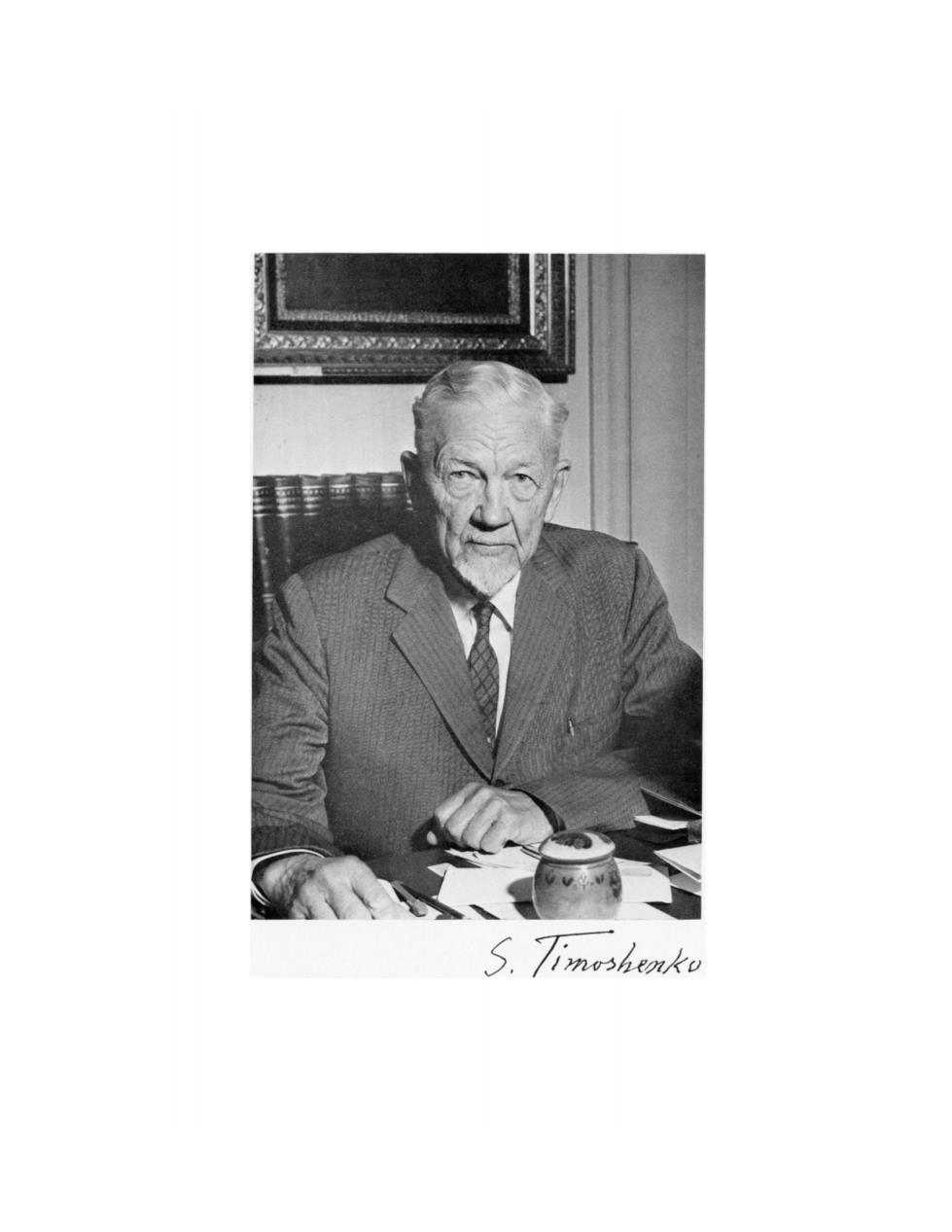
892NA S.mohk知

680 Biographical Memoirs The first period in America finds Timoshenko in the role of research engineer, first in Philadelphia and then with the Westinghouse Company in Pittsburgh. This period extended from 1922 to 1928.The second period(1928-36)consti- tutes his eight years at the University of Michigan and marks his return to academic life.Without doubt,these years represent the high point of his impact on American engineering education.The third period,which he spent at Stanford University,was the longest in his life.It extended from 1936 until 1965,at which time he returned to Europe to live with his daughter in West Germany.Except for summer trips to Switzerland and one to Russia,he remained there until his death on 29 May 1972,at the age of 93. THE RUSSIAN YEARS Period of formal education Stephen Timoshenko was born in the village of Shpotovka in Konotop County of Ukrainia on 23 December 1878.After early education at home, he entered the real-gymnasium in the town of Romni in 1889 and graduated in 1896 at the age of 18.He had prepared himself well for the competitive entrance examination to the Institute of Engineers of Ways of Communication and was admitted to this school in September 1896.Here he began his studies to become a railway structural engineer,a dream that he had held since early childhood.However,a trip to the International Exposition in Paris during the summer of 1900 convinced him that there were many new and more interesting subjects than railroads to be studied.In the section devoted to engineering structures were exhibited many models of different bridges,roofs, canals and harbour installations.Of particular interest to Timoshenko was a model of the big arch viaduct over the river Viaur near the town of Carmoux. This viaduct,which incorporated the biggest cantilever arch in the world,was in the process of being built and Timoshenko resolved to go and see it.He spent a fascinating three weeks at the site where the construction was under the supervision of a Monsieur Compagnon who had previously supervised the construction of the Eiffel Tower.On his return to the Institute a further year of studies was necessary before graduating in 1901.This was followed by a year of compulsory military training before Timoshenko was ready to start his professional career as a research worker and teacher of applied mechanics. In August 1902 Timoshenko married Alexandra Archangelskaya,a final-year medical school student whom he had known since his student days.They managed to make ends meet by renting a three-roomed apartment which they shared with Timoshenko's brothers. Period of scientific work Timoshenko's first job was that of laboratory instructor at the Institute's Mechanics Laboratory,which he began in the autumn of 1902 and for which he was paid 100 roubles per month.His duties consisted of making extensive experimental studies of strength of rails,structural steel and cement.He

Stephen Prokofievitch Timoshenko 681 realized that to make progress in his chosen field he would require a greater knowledge of mathematics,but the mathematics courses available were of an abstract nature totally divorced from the realms of engineering application. It was A.N.Krylov who pointed out to Timoshenko that the engineer had to study the old books rather than the new in mathematics.The following year, he obtained an instructorship at the newly organized St Petersburg Polytechnical Institute.The years 1903 to 1906 which he spent there mark the beginning of Timoshenko's creative scientific work in the direction of utilizing mathematics to solve engineering problems.His summers were spent in Germany,where he studied under such men as August Foppl,Ludwig Prandtl and Felix Klein. After his return from Germany in 1904,he wrote his first paper on the subject of Various strength theories.Following this,in the spring of 1905,he published a paper On the phenomenon of resonance in shafts.This work took into account the effect of the distributed mass of the shaft which had never before been considered.It showed the influence on Timoshenko of Lord Rayleigh's books, Theory of sound,and represents the first time that Rayleigh's method'was applied to an engineering problem.His earlier interest in the theories of strength of materials led him naturally to study the theory of elasticity and,in particular, the book by A.E.H.Love.Not knowing the English language he spent several months translating Love's book with the aid of a dictionary,working at it for two hours a day.He soon acquired sufficient working knowledge of the language to enable him to understand the technical literature. In 1905,Timoshenko began work on lateral buckling of I-beams under Prandtl's direction in Germany.He soon found that in order to approach the problem of buckling,he had to know something about the torsion of an I-beam. Obviously,the Saint-Venant theory of torsion was not applicable and he had to develop something new.He says that it took him about two weeks to figure out that instead of the usual torsion equation T=CΦ he had to develop the equation T=CΦ'-DΦ" where D is a constant depending on the bending rigidity of the flanges and the distance between them.This was the beginning of the concept of the warping constant used today in the discussion of torsion of prismatic bars of thin-walled open cross section. Timoshenko again went to Germany in the summer of 1906 and on this occasion he began some work on the buckling of plates.He was acquainted with the work of Bryan,who had found critical values of compressive stresses by strain energy considerations.Timoshenko,working directly with the differ- ential equation for the deflexion of the plate,succeeded in establishing critical values of the compressive stress from the boundary conditions.A paper describing this work was published in the spring of 1907.In later years,the tables and diagrams presented in this paper were widely used by ship-builders and by aircraft designers.Several other papers dealing with stability problems

682 Biographical Memoirs followed in rapid succession,and this may well be regarded as one of the most productive periods in his career. All these investigations on elastic stability showed that only the simplest cases could be solved rigorously.This led Timoshenko to develop an approxi- mate method of solution based on a comparison of strain energies of a system in its initial and buckled shapes.The method was similar to that used by Rayleigh for approximate calculations of frequencies of natural vibration and again shows the influence of Rayleigh's book on Timoshenko's work.This was the first time that the so-called Rayleigh-Ritz method'had been applied to problems in the field of stability.This ability to see that certain ideas developed for work in one area could be transferred to another and made to yield rich results was characteristic of many of Timoshenko's contributions.The results of this work won Timoshenko the Jourawsky prize,awarded once every ten years for the best paper on structural mechanics.It was later translated into French and published in the Annales des Ponts et Chaussees in 1913.It had great influence on further developments in the field of elastic stability. In 1906,when he was only 28 years old,Timoshenko took part in the open competition for a professorship at Kiev Polytechnic.He received word in November that he had been selected to the professorship in strength of materials. He began his lectures in this subject in January 1907.It was at this time that he developed the technique of beginning a course with a discussion of the simplest cases and only gradually building up to full generalizations.This was contrary to the customary procedure of beginning with a general discussion of stress and strain in three dimensions and gradually working down to o =P/A. It proved so successful that in subsequent years of teaching he always used this approach in his classes;it was much appreciated by students.After developing the course in strength of materials,Timoshenko expanded his notes into a textbook on the subject,which first appeared in 1911.This was the first of his many textbooks on applied mechanics. In addition to the work on the application of energy methods to stability problems already discussed,Timoshenko also developed at.this time some valuable applications of normal coordinates to the solution of problems of bending of beams and plates.This was also extended to cases of combined bending and compression or tension and to forced vibrations of beams.This work is described in a paper,Etude de la flexion des barres,Annales des Travaux de Belgique,1914,and another,Erzwungene Schwingungen prismatischer Stabe,Zeitschrift fuir Mathematik und Physik,1911. In 1909,Timoshenko was elected dean of the civil engineering school at Kiev Polytechnic.This promotion to administrative levels not only interfered with his teaching and scientific work but was also the forerunner of serious trouble for him.There had been considerable political unrest and student demonstra- tions some six years earlier which had necessitated the closure of all institutions of higher learning for several months.The institutions were reopened in the autumn of 1906 after various revolutionary demands had been met;these including the granting of a constitution,the convocation of a State Duma and a
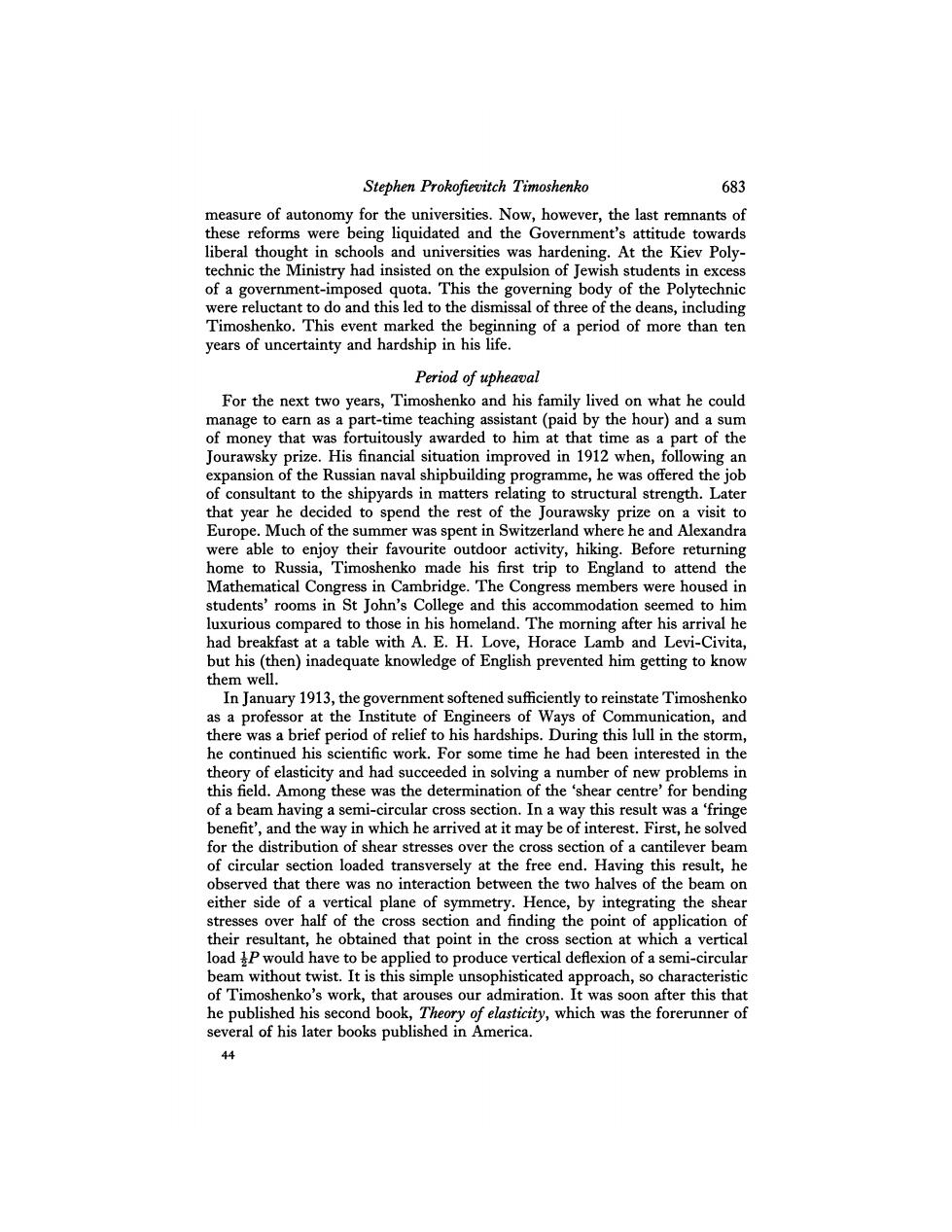
Stephen Prokofievitch Timoshenko 683 measure of autonomy for the universities.Now,however,the last remnants of these reforms were being liquidated and the Government's attitude towards liberal thought in schools and universities was hardening.At the Kiev Poly- technic the Ministry had insisted on the expulsion of Jewish students in excess of a government-imposed quota.This the governing body of the Polytechnic were reluctant to do and this led to the dismissal of three of the deans,including Timoshenko.This event marked the beginning of a period of more than ten years of uncertainty and hardship in his life. Period of upheaval For the next two years,Timoshenko and his family lived on what he could manage to earn as a part-time teaching assistant(paid by the hour)and a sum of money that was fortuitously awarded to him at that time as a part of the Jourawsky prize.His financial situation improved in 1912 when,following an expansion of the Russian naval shipbuilding programme,he was offered the job of consultant to the shipyards in matters relating to structural strength.Later that year he decided to spend the rest of the Jourawsky prize on a visit to Europe.Much of the summer was spent in Switzerland where he and Alexandra were able to enjoy their favourite outdoor activity,hiking.Before returning home to Russia,Timoshenko made his first trip to England to attend the Mathematical Congress in Cambridge.The Congress members were housed in students'rooms in St John's College and this accommodation seemed to him luxurious compared to those in his homeland.The morning after his arrival he had breakfast at a table with A.E.H.Love,Horace Lamb and Levi-Civita, but his(then)inadequate knowledge of English prevented him getting to know them well. In January 1913,the government softened sufficiently to reinstate Timoshenko as a professor at the Institute of Engineers of Ways of Communication,and there was a brief period of relief to his hardships.During this lull in the storm, he continued his scientific work.For some time he had been interested in the theory of elasticity and had succeeded in solving a number of new problems in this field.Among these was the determination of the 'shear centre'for bending of a beam having a semi-circular cross section.In a way this result was a fringe benefit',and the way in which he arrived at it may be of interest.First,he solved for the distribution of shear stresses over the cross section of a cantilever beam of circular section loaded transversely at the free end.Having this result,he observed that there was no interaction between the two halves of the beam on either side of a vertical plane of symmetry.Hence,by integrating the shear stresses over half of the cross section and finding the point of application of their resultant,he obtained that point in the cross section at which a vertical load P would have to be applied to produce vertical deflexion of a semi-circular beam without twist.It is this simple unsophisticated approach,so characteristic of Timoshenko's work,that arouses our admiration.It was soon after this that he published his second book,Theory of elasticity,which was the forerunner of several of his later books published in America. 44
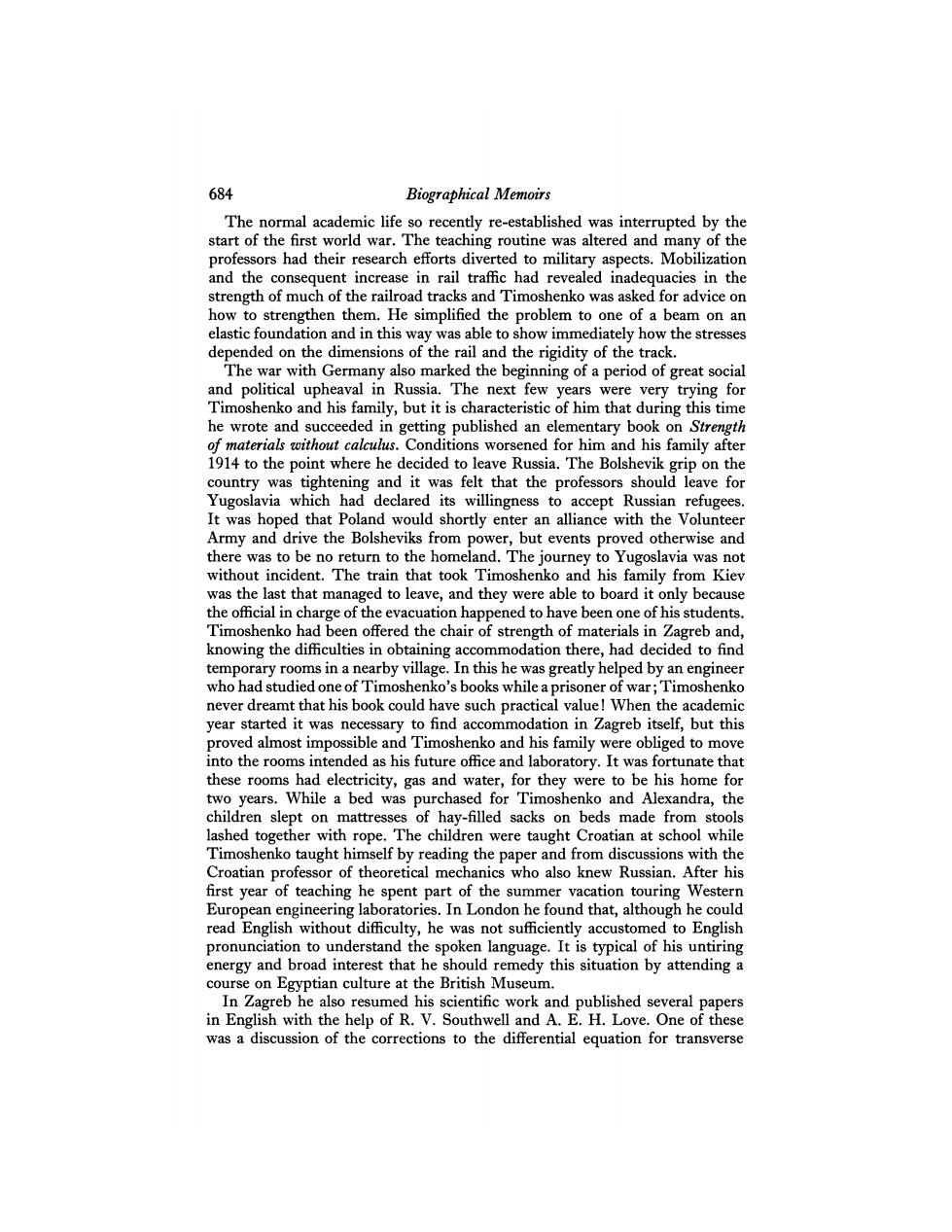
684 Biographical Memoirs The normal academic life so recently re-established was interrupted by the start of the first world war.The teaching routine was altered and many of the professors had their research efforts diverted to military aspects.Mobilization and the consequent increase in rail traffic had revealed inadequacies in the strength of much of the railroad tracks and Timoshenko was asked for advice on how to strengthen them.He simplified the problem to one of a beam on an elastic foundation and in this way was able to show immediately how the stresses depended on the dimensions of the rail and the rigidity of the track. The war with Germany also marked the beginning of a period of great social and political upheaval in Russia.The next few years were very trying for Timoshenko and his family,but it is characteristic of him that during this time he wrote and succeeded in getting published an elementary book on Strength of materials without calculus.Conditions worsened for him and his family after 1914 to the point where he decided to leave Russia.The Bolshevik grip on the country was tightening and it was felt that the professors should leave for Yugoslavia which had declared its willingness to accept Russian refugees. It was hoped that Poland would shortly enter an alliance with the Volunteer Army and drive the Bolsheviks from power,but events proved otherwise and there was to be no return to the homeland.The journey to Yugoslavia was not without incident.The train that took Timoshenko and his family from Kiev was the last that managed to leave,and they were able to board it only because the official in charge of the evacuation happened to have been one of his students Timoshenko had been offered the chair of strength of materials in Zagreb and, knowing the difficulties in obtaining accommodation there,had decided to find temporary rooms in a nearby village.In this he was greatly helped by an engineer who had studied one of Timoshenko's books while a prisoner of war;Timoshenko never dreamt that his book could have such practical value!When the academic year started it was necessary to find accommodation in Zagreb itself,but this proved almost impossible and Timoshenko and his family were obliged to move into the rooms intended as his future office and laboratory.It was fortunate that these rooms had electricity,gas and water,for they were to be his home for two years.While a bed was purchased for Timoshenko and Alexandra,the children slept on mattresses of hay-filled sacks on beds made from stools lashed together with rope.The children were taught Croatian at school while Timoshenko taught himself by reading the paper and from discussions with the Croatian professor of theoretical mechanics who also knew Russian.After his first year of teaching he spent part of the summer vacation touring Western European engineering laboratories.In London he found that,although he could read English without difficulty,he was not sufficiently accustomed to English pronunciation to understand the spoken language.It is typical of his untiring energy and broad interest that he should remedy this situation by attending a course on Egyptian culture at the British Museum. In Zagreb he also resumed his scientific work and published several papers in English with the help of R.V.Southwell and A.E.H.Love.One of these was a discussion of the corrections to the differential equation for transverse
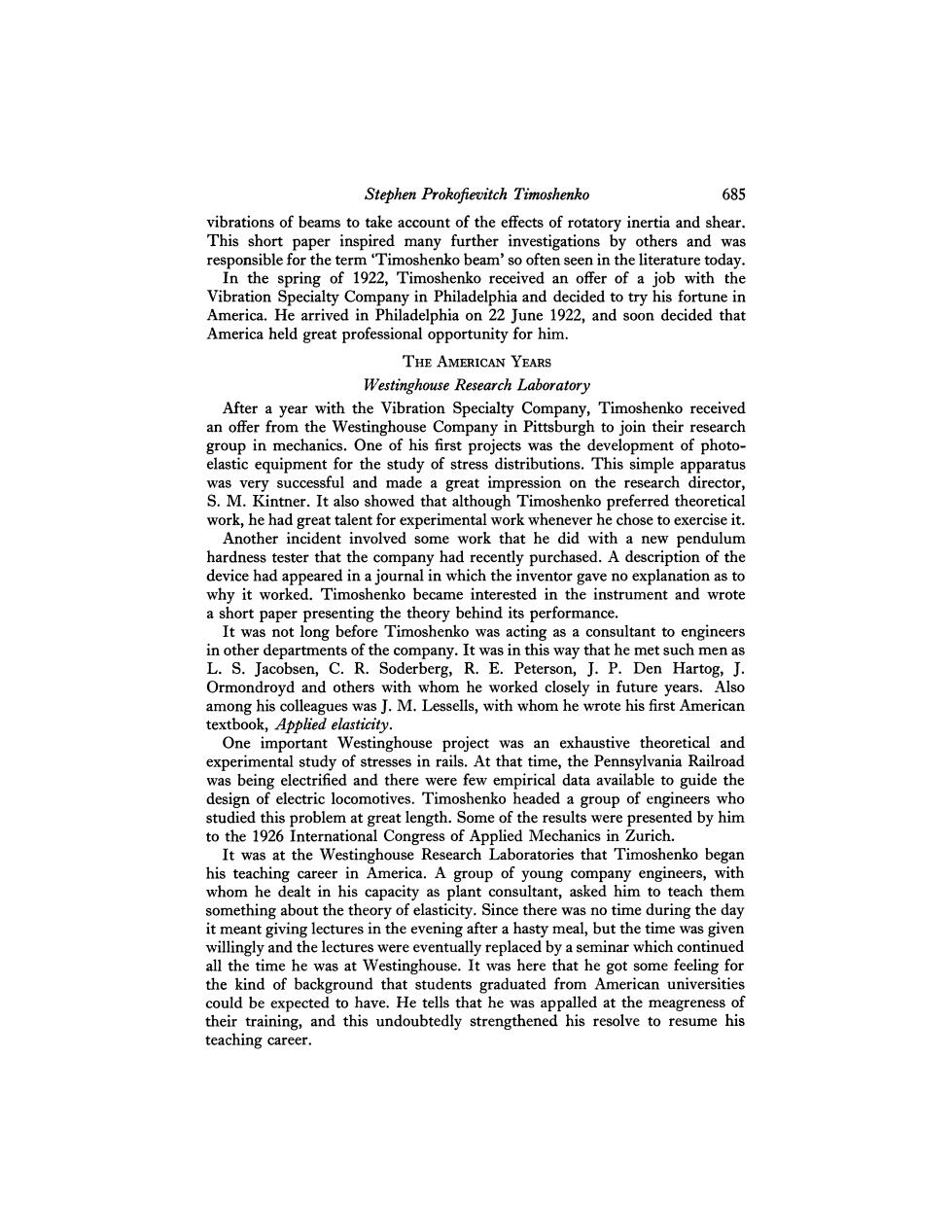
Stephen Prokofievitch Timoshenko 685 vibrations of beams to take account of the effects of rotatory inertia and shear. This short paper inspired many further investigations by others and was responsible for the term "Timoshenko beam'so often seen in the literature today. In the spring of 1922,Timoshenko received an offer of a job with the Vibration Specialty Company in Philadelphia and decided to try his fortune in America.He arrived in Philadelphia on 22 June 1922,and soon decided that America held great professional opportunity for him. THE AMERICAN YEARS Westinghouse Research Laboratory After a year with the Vibration Specialty Company,Timoshenko received an offer from the Westinghouse Company in Pittsburgh to join their research group in mechanics.One of his first projects was the development of photo- elastic equipment for the study of stress distributions.This simple apparatus was very successful and made a great impression on the research director, S.M.Kintner.It also showed that although Timoshenko preferred theoretical work,he had great talent for experimental work whenever he chose to exercise it. Another incident involved some work that he did with a new pendulum hardness tester that the company had recently purchased.A description of the device had appeared in a journal in which the inventor gave no explanation as to why it worked.Timoshenko became interested in the instrument and wrote a short paper presenting the theory behind its performance. It was not long before Timoshenko was acting as a consultant to engineers in other departments of the company.It was in this way that he met such men as L.S.Jacobsen,C.R.Soderberg,R.E.Peterson,J.P.Den Hartog,J. Ormondroyd and others with whom he worked closely in future years.Also among his colleagues was J.M.Lessells,with whom he wrote his first American textbook,Applied elasticity. One important Westinghouse project was an exhaustive theoretical and experimental study of stresses in rails.At that time,the Pennsylvania Railroad was being electrified and there were few empirical data available to guide the design of electric locomotives.Timoshenko headed a group of engineers who studied this problem at great length.Some of the results were presented by him to the 1926 International Congress of Applied Mechanics in Zurich. It was at the Westinghouse Research Laboratories that Timoshenko began his teaching career in America.A group of young company engineers,with whom he dealt in his capacity as plant consultant,asked him to teach them something about the theory of elasticity.Since there was no time during the day it meant giving lectures in the evening after a hasty meal,but the time was given willingly and the lectures were eventually replaced by a seminar which continued all the time he was at Westinghouse.It was here that he got some feeling for the kind of background that students graduated from American universities could be expected to have.He tells that he was appalled at the meagreness of their training,and this undoubtedly strengthened his resolve to resume his teaching career

686 Biographical Memoirs Another incident which took place while Timoshenko was at Westinghouse may shed some light on the early opinions he formed about American schools and American professors.At a meeting of the American Society of Mechanical Engineers in 1925,he presented a paper on stress concentration produced by a circular hole.In a discussion presented by a well-known professor of civil engineering at Harvard Engineering School,both Timoshenko and the paper were bitterly attacked.Among other things,Timoshenko was told:'You have undoubtedly great ability.I wish you could turn it to useful purposes rather than misuse it by advocating formulae and methods which are purely mathe- matical and based on false assumptions....Mathematics is a valuable tool, but a dangerous one.We must take care that the criticism that engineers are theoretical is not justified.'In his reply,Timoshenko did not mince words to reveal the total ignorance behind this attack.His audience,in agreement, rewarded him with thunderous applause.This biting performance was the only one he gave in America;the knowledge that he knew how to defend himself made the critics much more wary! While still at Westinghouse,Timoshenko was instrumental in organizing the Mechanics Division of the American Society of Mechanical Engineers.This division was formally launched in 1928.Today,the Yournal of Applied Mechanics is world famous and the leading publication in its field. The University of Michigan Timoshenko resumed his academic life at the University of Michigan in the autumn of 1928.He got off to an inauspicious start by being late for his first lecture.An American watch that his wife had given him as a present had failed to keep proper time and he was more than a little upset by this.However,this incident was far from portending his future there.He offered his classes in the afternoon hours so they would not conflict with required courses and very soon had a tremendous following.He would enter the classroom exactly as the bell sounded and without any preliminaries would begin his lecture.The ease and clarity with which he presented even the most difficult subject matter were a constant source of pleasure and admiration to those who attended.His command of the subject was so complete that his entire mind was free to be aware of the students'reactions as they sat before him.He could sense a question and answer it before it could be asked.Students were unanimous in their opinion that he was the greatest teacher they had ever had. Activities in graduate mechanics at Michigan increased rapidly.Timoshenko organized weekly seminars that were attended not only by students but by faculty members from all of the engineering departments.As his reputation grew,it became the custom to hold in Ann Arbor each year a special summer session in applied mechanics.These summer sessions were attended largely by faculty members from other universities so that very soon Timoshenko's ideas and attitude towards mechanics became widespread throughout America. During these summer sessions,an outstanding guest lecturer besides Timoshenko himself was invited to participate.On different occasions Michigan
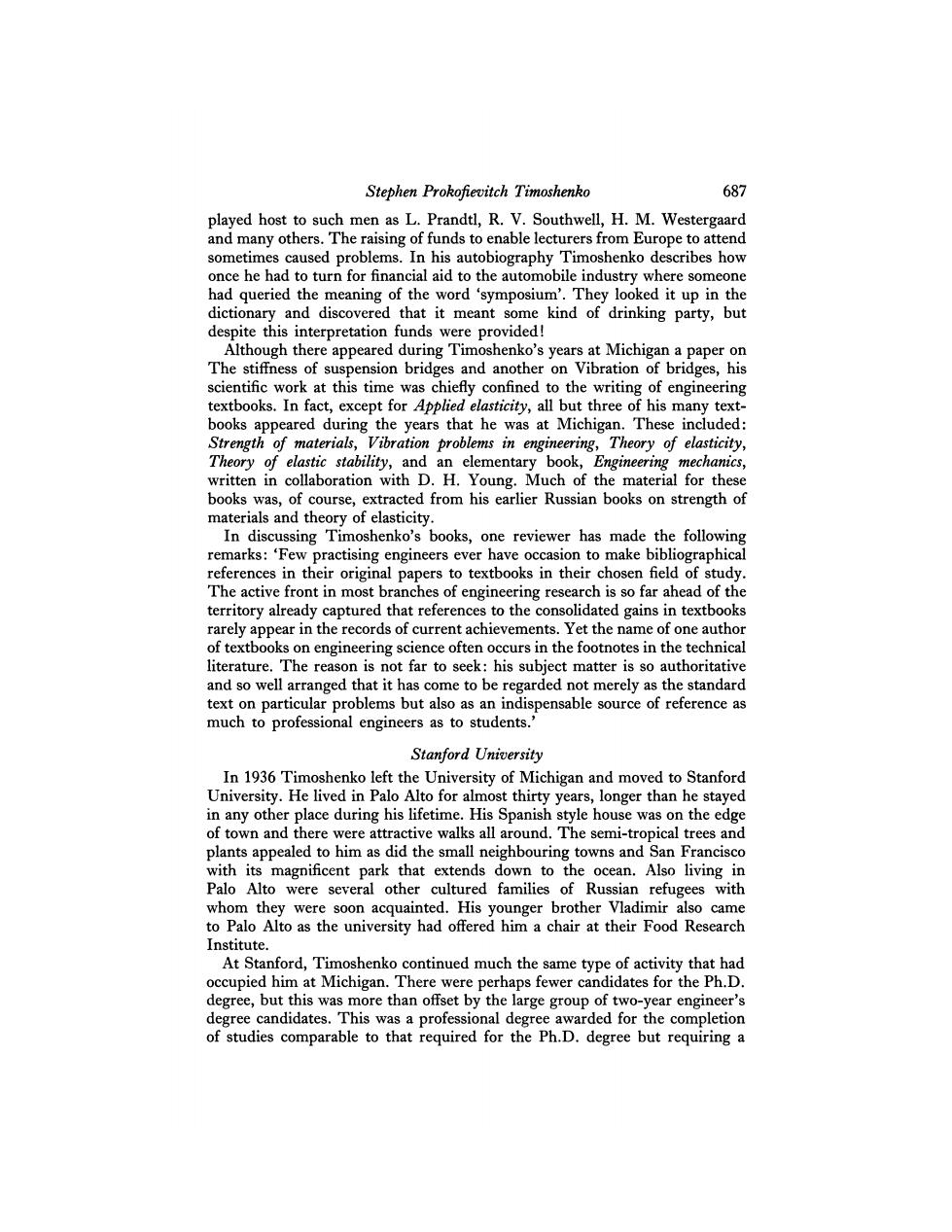
Stephen Prokofievitch Timoshenko 687 played host to such men as L.Prandtl,R.V.Southwell,H.M.Westergaard and many others.The raising of funds to enable lecturers from Europe to attend sometimes caused problems.In his autobiography Timoshenko describes how once he had to turn for financial aid to the automobile industry where someone had queried the meaning of the word 'symposium'.They looked it up in the dictionary and discovered that it meant some kind of drinking party,but despite this interpretation funds were provided! Although there appeared during Timoshenko's years at Michigan a paper on The stiffness of suspension bridges and another on Vibration of bridges,his scientific work at this time was chiefly confined to the writing of engineering textbooks.In fact,except for Applied elasticity,all but three of his many text- books appeared during the years that he was at Michigan.These included: Strength of materials,Vibration problems in engineering,Theory of elasticity, Theory of elastic stability,and an elementary book,Engineering mechanics, written in collaboration with D.H.Young.Much of the material for these books was,of course,extracted from his earlier Russian books on strength of materials and theory of elasticity. In discussing Timoshenko's books,one reviewer has made the following remarks:Few practising engineers ever have occasion to make bibliographical references in their original papers to textbooks in their chosen field of study. The active front in most branches of engineering research is so far ahead of the territory already captured that references to the consolidated gains in textbooks rarely appear in the records of current achievements.Yet the name of one author of textbooks on engineering science often occurs in the footnotes in the technical literature.The reason is not far to seek:his subject matter is so authoritative and so well arranged that it has come to be regarded not merely as the standard text on particular problems but also as an indispensable source of reference as much to professional engineers as to students.' Stanford University In 1936 Timoshenko left the University of Michigan and moved to Stanford University.He lived in Palo Alto for almost thirty years,longer than he stayed in any other place during his lifetime.His Spanish style house was on the edge of town and there were attractive walks all around.The semi-tropical trees and plants appealed to him as did the small neighbouring towns and San Francisco with its magnificent park that extends down to the ocean.Also living in Palo Alto were several other cultured families of Russian refugees with whom they were soon acquainted.His younger brother Vladimir also came to Palo Alto as the university had offered him a chair at their Food Research Institute. At Stanford,Timoshenko continued much the same type of activity that had occupied him at Michigan.There were perhaps fewer candidates for the Ph.D. degree,but this was more than offset by the large group of two-year engineer's degree candidates.This was a professional degree awarded for the completion of studies comparable to that required for the Ph.D.degree but requiring a